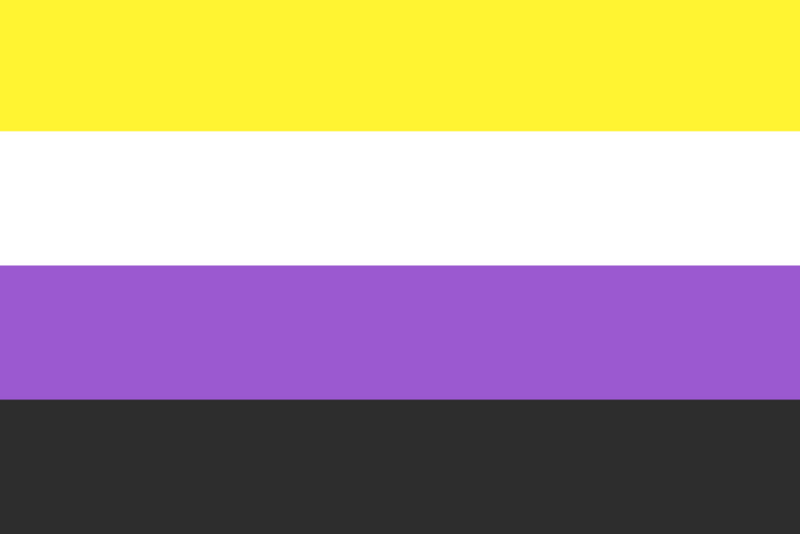The nonbinary flag represents nonbinary people in the LGBTQ+ community. This post is all about the nonbinary pride flag and gender identity.
Who are Nonbinary People?
Non-binary is a commonly used word to describe people who do not identify as men or women. The gender binary describes two genders only, male and female, which is quite limiting. I am a nonbinary person, and chose that terminology to represent that I do not feel like a woman or a man within the cultural limitations of my community.
Pride protests and celebrations have a history since the 1969 Stonewall riot. The celebrations get bigger and more inclusive every year. Today, Pride events celebrate a diverse range of sexuality, gender identities, and cultures. Cities all around the world hold Pride parades to celebrate the LGBTQ+ community. The nonbinary pride flag is one of the representative banners you may see in a parade or celebration.
Nonbinary Gender Identity Facts
Nonbinary people are not confused about their gender identity or orientation. The idea of being nonbinary is not new or recent. Nonbinary identities have been known and recognized by societies around the world for millennia.
European colonizers imposed rigid binary gender rules on the societies they invaded. The patriarchal system was a way for white cisgender men to gain widespread control over a population.
Some people are both transgender and nonbinary, but these identities are not equivalent. There are people who are trans but not nonbinary (a binary trans woman, for example) and people who are nonbinary but not trans. If in doubt, mirror the language that someone uses for themself if you have to speak about their gender identity.
Some common gender-neutral terms to use for nonbinary people include people, folks, child, sibling, parent, spouse, grandparent, and so on.
There are no specific “nonbinary pronouns”! Some nonbinary people use gender neutral pronouns, such as they/them. Some nonbinary people use neopronouns, such as zie/zir or e/em. Some nonbinary people use masculine or feminine pronouns, he/him or she/her. Combinations of pronouns, for example alternating between she/her and they/them, or not having a preference between any pronouns (he/she/they) are other options to represent being nonbinary.
History of the Nonbinary Pride Flag
The genderqueer pride flag was created before the nonbinary pride flag. Marilyn Roxie, a writer and video artist, created a flag for the genderqueer community in 2010. The intention was to carry the flag at the Pride parade. The flag has 3 different colors that represent different aspects of the genderqueer community.
Four years later in 2014, Kye Rowan created the Nonbinary Pride Flag for the nonbinary community. This flag has 4 colors that symbolize aspects of being nonbinary.
Nonbinary Flag Colors
Yellow signifies individuality outside the gender binary of male and female.
White stands for multi gender people since many colors are mixed together to create white.
Purple or lavender represents the genderqueer community with a blend of male and female genders.
Black signifies agender people where an absence of color stands for the absence of gender.
The colors of the Nonbinary Pride Flag represent the experience of nonbinary people. Nonbinary people have proudly waved the flag at Pride parades around the world.
International Non-Binary People’s Day
July 14 is dedicated to nonbinary people and celebrated as International Non-Binary People's Day around the world. The idea is to highlight the problems faced by nonbinary people and raise awareness on equality issues. The date was chosen between International Men's and Women's Day. It was first celebrated in the year 2012.
Tips to Be Supportive to Nonbinary Folks
You don’t need to understand or relate to someone’s gender identity to respect them as a person. I and other nonbinary people deserve the same amount of respect as any other living being. Be open to learning about nonbinary identities and it will become easier to communicate.
If you are not sure how to address a nonbinary person, simply call them by their name. Don’t ask for or use their previous name, if they have changed their name.
Please ask what pronouns someone uses (like she/her, they/them, or he/him), if you don’t know. You can also check someone’s social media bio, website, or email signature to find their pronouns.
It is impossible to determine if a person is nonbinary simply by their physical appearance. Try not to make assumptions (that a person is cisgender, transgender, or nonbinary). You may find out that a person is nonbinary from talking to them if they choose to share this personal identity with you.
Nonbinary people should have the rights to live, dress, and work freely as they desire. We deserve respect. It is important for us to advocate for equitable policies for nonbinary people.
Learn more about nonbinary people:
10 Best Ways to Support Your Nonbinary Partner
My favorite books by trans, nonbinary, and agender authors, on Bookshop.org
So, this July 14, International Non-Binary Peoples Day, will you be displaying the nonbinary flag? If you are a nonbinary person or want to show your support to a nonbinary friend, it’s a great way to stand up for equality and diversity.









